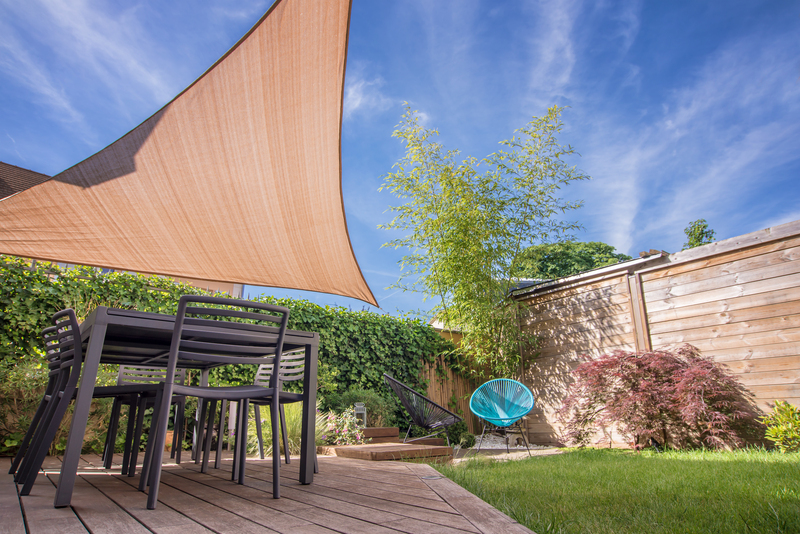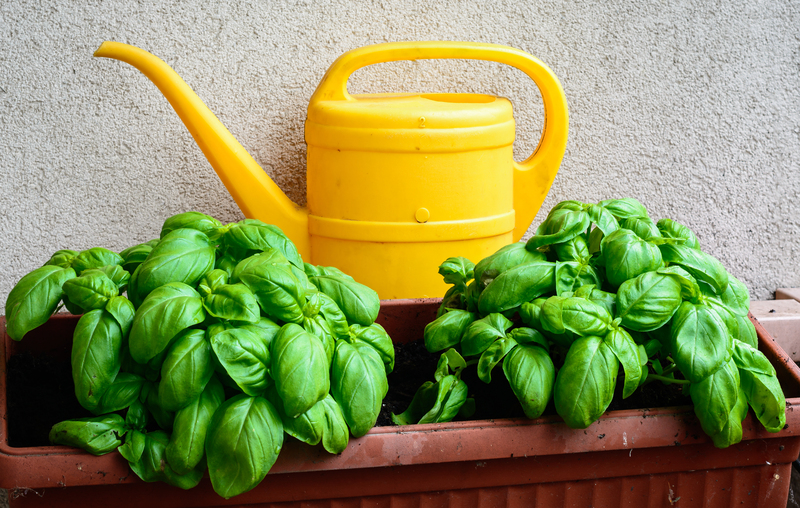Nurture Nature: A Comprehensive Guide to Starting a Herb Garden
Posted on 18/06/2025
Nurture Nature: A Comprehensive Guide to Starting a Herb Garden
Are you fascinated by the idea of plucking fresh herbs right from your window sill or backyard? Nothing beats the aroma and flavor of freshly harvested herbs, and growing your own offers both culinary rewards and a meditative connection with nature. Starting a herb garden is a delightful journey--it's low-cost, beginner-friendly, and can fit any space. This comprehensive guide will walk you through how to nurture nature by establishing a thriving herb garden, whether you have sprawling outdoor beds or just a sunny kitchen window.
Why You Should Start a Herb Garden
Before delving into the practicalities, let's explore the benefits of growing herbs at home:
- Health and Flavor: Fresh herbs pack a nutritional punch and elevate any dish with vibrant flavor.
- Cost-effective: Home-grown herbs save money--no more buying expensive bunches from the supermarket that wilt in days.
- Eco-friendly: You'll reduce packaging waste and carbon footprint.
- Well-being: Gardening is a mood booster and a soothing hobby.
- Beauty and Biodiversity: Herb gardens attract pollinators and add greenery to your space.
With so many advantages, it's easy to see why cultivating a personal herb garden is a wise choice. Let's learn how to transform your gardening dreams into reality.

Choosing the Best Herbs for Beginners
If you're new to gardening, start simple. Here are some herbs ideal for beginners due to their resilience and versatility:
- Basil: A kitchen staple, basil grows quickly and thrives in pots or beds.
- Mint: Fantastic for teas and desserts, but best grown in containers due to its invasive nature.
- Parsley: Hardy and slow to bolt, adding fresh flavor to myriad dishes.
- Chives: Easy to maintain and perfect for continuous cutting.
- Cilantro (Coriander): Gives both flavorful leaves and seeds.
- Rosemary: Aromatic and drought-resistant once established.
- Oregano: Robust, makes an excellent perennial in mild climates.
- Thyme: Compact, resilient, and very flavorful.
These starter herbs suit both outdoor and indoor herb gardens, ensuring you enjoy success from the beginning.
Planning Your Herb Garden: Location and Design
Outdoor Herb Gardens
Consider the following when setting up an outdoor herb garden:
- Sunlight: Most herbs require 6-8 hours of sunlight daily. Choose a south or west-facing area.
- Soil: Well-draining, fertile soil is essential. Add compost or organic matter to enrich clay or sandy soils.
- Drainage: Ensure water doesn't pool in your herb beds--a raised bed can help.
- Layout: Group herbs with similar water and sun needs together. Consider accessibility for frequent harvesting.
Indoor Herb Gardens
Don't have outdoor space? Herb gardening indoors is entirely possible!
- Pick a sunny spot: A south-facing window or anywhere with at least 6 hours of light is ideal.
- Pots and containers: Use containers with drainage holes. Terra cotta pots are especially good for moisture control.
- Soil for containers: Use high-quality potting mix, not regular garden soil.
- Rotation and light supplementation: Rotate pots regularly, and consider using LED grow lights if sunlight is scarce.
Gathering Supplies for Your Herb Garden
A successful herb gardening project starts with the right tools and materials. Here's what you'll need:
- Seeds or starter plants: Seeds are cost-effective; starter plants offer a head start.
- Soil: For containers, use a quality organic potting mix; for beds, enrich soil with compost.
- Containers or beds: Choose based on your space. Herbs can thrive in raised beds, garden plots, window boxes, or individual pots.
- Labels: To identify herbs, especially when seedlings look similar.
- Gardening tools: Trowel, watering can, gloves, and pruners will make things easier.
- Mulch (optional): Helps retain moisture and suppress weeds in outdoor beds.
How to Plant Herbs: Seeds vs. Seedlings
Should you start from seed or buy young herb plants? Both options have advantages:
- Growing from seed is budget-friendly and offers a broad selection of varieties. Sow seeds according to packet instructions, generally after the last frost.
- Using seedlings or starter plants provides instant gratification and a head start, ideal if you want quick harvests or have a short growing season.
How to Sow Seeds
- Fill your container with moistened potting mix or prepare outdoor beds by loosening and enriching the soil.
- Sow seeds as directed--some need light to germinate, so don't cover them deeply.
- Keep the soil lightly moist (not soggy) until seeds sprout.
- Once seedlings develop, thin them according to spacing recommendations.
Planting Seedlings
- Dig a hole large enough for the root ball.
- Gently remove the herb plant from its pot, loosen any circling roots, and set it at the same depth.
- Backfill with soil, firm gently, and water well.
- Label each plant for easy identification.
Essential Tips for Nurturing Your Herb Garden
1. Water Wisely
Most herbs prefer consistently moist, well-draining soil, but hate being waterlogged. Stick your finger an inch into the soil--if it's dry at that depth, it's time to water. Morning is the best time to water, reducing evaporation and preventing fungal issues.
2. Feed Occasionally
Herbs don't demand much fertilization. Use a balanced organic fertilizer or add compost every few months for vigorous growth, especially in containers, which can lose nutrients quickly.
3. Prune and Harvest Regularly
- Pinch back new growth to encourage bushiness.
- Harvest often and remove flower buds (except for chives and lavender) to keep plants productive.
- Never take more than one-third of the plant at a time; allow it to recover.
4. Protect from Pests and Disease
Pests and disease are rare, but monitor for aphids, slugs, or fungal spots. Pick pests off by hand, use a mild soap spray, or encourage beneficial insects like ladybugs. Proper spacing and airflow help prevent most problems.
Seasonal Tips for a Thriving Herb Garden
Spring and Summer
- Plant tender annuals (basil, cilantro) after the last frost.
- Mulch outdoor beds to conserve moisture and suppress weeds.
- Keep harvesting to promote continuous production.
Autumn
- Begin harvesting and preserving (drying or freezing) herbs for winter use.
- Bring potted herbs indoors before the first frost or provide protection for tender perennials.
Winter
- Continue growing hardy herbs like chives, parsley, and thyme on a sunny windowsill.
- Reduce watering and avoid fertilizing until active growth resumes in spring.
Creative Herb Garden Ideas
Nurture nature in every corner of your home with these herb gardening ideas:
- Vertical Herb Walls: Use stacked planters, pallets, or pocket organizers to save space indoors or outdoors.
- Windowsill Gardens: Line up small pots on a sunny sill for fresh snips as you cook.
- Hanging Baskets: Let mint or trailing herbs cascade from a porch or balcony.
- Mason Jar Planters: Attractive and practical, they're perfect for kitchens with limited space.
- Spiral Herb Gardens: Outdoor spirals maximize planting area and microclimates for different herbs.
Harvesting, Preserving, and Using Your Herbs
How to Harvest
- Snip early in the day after the dew dries but before the hot sun reduces essential oils.
- Use clean, sharp scissors or pruners to prevent damage to plants.
- Encourage regrowth by cutting just above a leaf node or set of leaves.
How to Preserve Fresh Herbs
- Drying: Tie small bunches and hang upside-down in a well-ventilated, dry location.
- Freezing: Chop herbs, pack into ice cube trays, fill with olive oil or water, then freeze. Transfer cubes to containers for easy use in soups or sautes.
- Infusions and Vinegars: Steep fresh herbs in olive oil or vinegar for delicious flavor additions.
Creative Culinary Uses
The best reward for nurturing a herb garden is the flavor it brings to your table. Here are some ideas:
- Pesto: Use basil, parsley, or cilantro for homemade pesto sauces.
- Herb Butters: Mix softened butter with chives, dill, or tarragon--perfect for bread or steaks.
- Teas: Brew mint, lemon balm, or chamomile for soothing herbal teas.
- Salads and Dressings: Toss chopped herbs into green salads for freshness and flavor.
- Marinades and Seasonings: Enhance meats, vegetables, and grains with herb-infused oils and spice blends.
Tips for Long-Term Success in Home Herb Gardening
- Rotate Crops: Change herb locations each year to discourage soil-borne disease.
- Refresh Potting Soil: Annually replace or rejuvenate the soil in your containers.
- Stay Curious: Try new herb varieties and experiment with different growing techniques.
- Share the Bounty: Give fresh, dried, or potted herbs as gifts to friends and family.
- Record Your Results: Keep a gardening journal to track what works best in your space.

Frequently Asked Questions About Herb Gardening
Can I grow herbs year-round?
Yes--many herbs thrive indoors through winter, provided they have enough light and warmth. Hardy perennial herbs, such as chives and thyme, can overwinter outdoors in milder climates.
Which herbs grow well together?
Some herbs with similar watering and light preferences make great companions. For instance, rosemary, thyme, oregano, and sage enjoy drier conditions, while basil, parsley, and cilantro like more moisture. Avoid planting mint with others--it spreads aggressively!
How do I prevent my herbs from bolting?
Bolting is when herbs like cilantro and basil prematurely flower and go to seed, often due to heat or irregular watering. To prevent this, keep up with frequent harvesting, maintain steady moisture, and provide partial shade during intense summer heat.
In Summary: Nurture Nature with Your Own Herb Garden
Starting a herb garden offers countless rewards: fresh ingredients, natural beauty, environmental benefits, and personal wellness. Whether you're a first-time gardener or a seasoned grower, nurturing an herb garden is a profound way to nurture nature right at home.
*Ready to cultivate your green thumb?* With this comprehensive herb gardening guide, you're equipped to design, plant, and enjoy the bounty of your very own herb oasis--indoors or out. Happy gardening!



